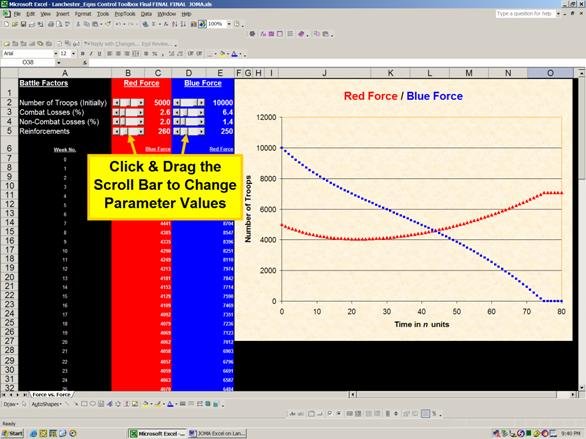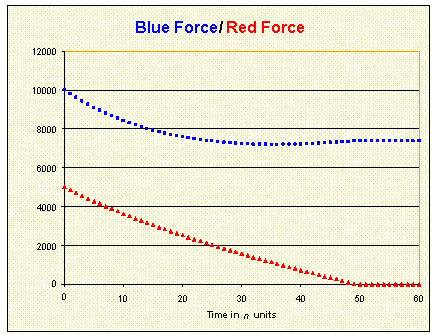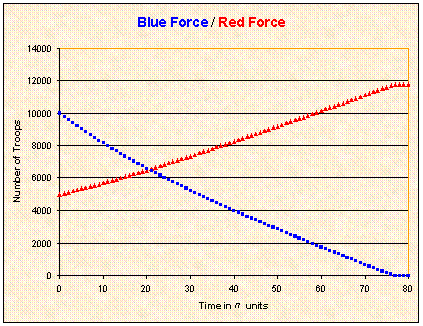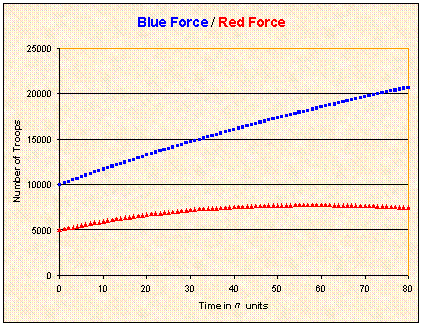An Interactive Use of the Lanchester Combat Model
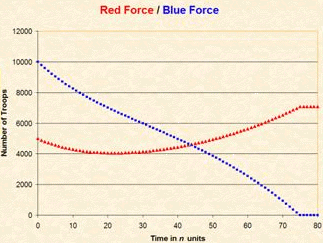 The business of war is a tough one, and, in all likelihood, one that will never go away. Our military forces are developing into a more complex entity, continually striving to better the total force and create a safer world. Many factors contribute to this process, but nothing is more crucial than those serving our country in uniform. When deterrence fails, how can we protect our most valuable resource? How do we win our wars? And before we even fight them, how do we plan for them?
The business of war is a tough one, and, in all likelihood, one that will never go away. Our military forces are developing into a more complex entity, continually striving to better the total force and create a safer world. Many factors contribute to this process, but nothing is more crucial than those serving our country in uniform. When deterrence fails, how can we protect our most valuable resource? How do we win our wars? And before we even fight them, how do we plan for them?
Could commanders better prepare for battle if a simple, interactive, unit-specific approach were made available in the planning process? And what if service members at all levels could interact with it? At the very least, service members could visualize the impact on readying the force in a variety of fashions. By employing a form of the Lanchester Combat Model in Microsoft Excel, such an tool is available.
Bart D. Stewart is in the Department of Mathematical Sciences at the U. S. Military Academy.
Published February, 2003
© 2003, Bart D. Stewart
An Interactive Use of the Lanchester Combat Model - Introduction
 The business of war is a tough one, and, in all likelihood, one that will never go away. Our military forces are developing into a more complex entity, continually striving to better the total force and create a safer world. Many factors contribute to this process, but nothing is more crucial than those serving our country in uniform. When deterrence fails, how can we protect our most valuable resource? How do we win our wars? And before we even fight them, how do we plan for them?
The business of war is a tough one, and, in all likelihood, one that will never go away. Our military forces are developing into a more complex entity, continually striving to better the total force and create a safer world. Many factors contribute to this process, but nothing is more crucial than those serving our country in uniform. When deterrence fails, how can we protect our most valuable resource? How do we win our wars? And before we even fight them, how do we plan for them?
Could commanders better prepare for battle if a simple, interactive, unit-specific approach were made available in the planning process? And what if service members at all levels could interact with it? At the very least, service members could visualize the impact on readying the force in a variety of fashions. By employing a form of the Lanchester Combat Model in Microsoft Excel, such an tool is available.
Bart D. Stewart is in the Department of Mathematical Sciences at the U. S. Military Academy.
Published February, 2003
© 2003, Bart D. Stewart
An Interactive Use of the Lanchester Combat Model - The Lanchester Combat Model
Since it was first proposed during World War I, the Lanchester Combat Model (Lanchester, 1916, Giordano, et al., 1997) in various forms has been used to address quantitatively the competition between opposing forces. The model not only provides insight as to who the victor may be, but it can also approximate how much of each force remains, how long the competing forces remain engaged, and how the changing conditions of battle can impact the outcome.
Consider two opposing forces – Red Force and Blue Force – with respective numbers of troops R(t) and B(t) at time t. Although time is often measured in hours or days, any time frame would suffice. Over time, the numbers of troops available for combat change for various reasons – perhaps the most important being combat losses.
Combat losses are indicative of the ability of one force to eradicate the other. When conventional forces meet, combat losses are considered to occur at a rate proportional to the number of troops of the opposing force. Assuming that the Blue Force and Red Force can inflict combat losses on each other at proportional rates of k1 and k3, respectively, we can model the changes in their troop numbers by
 ,
,  .
.
While combat losses account for much of the change on the battlefield, non-combat losses can further degrade troop availability. We assume that the forces sustain these losses at rates proportional to their own numbers. Thus, if the proportionality constants are k2 for the Red Force and k4 for the Blue Force, the model becomes
 ,
,  .
.
The final component of this model is troop reinforcement. With the Red Force and Blue Force getting reinforcements at rates of r(t) and b(t), respectively, the combat model with initial conditions becomes
 ,
,  ;
;
 ,
,  .
.
An Interactive Use of the Lanchester Combat Model - Approximating the Model
When applied to a large but finite number of steps, difference equations can closely approximate the continuous behavior of differential equations. In fact, the continuous model can be seen as a limit of the discrete model. To illustrate this point, we consider the generic Euler discrete approximation method, derived by letting a difference quotient approximate the derivative:

In discrete terms, it is easy to measure the changes occurring on the battlefield by comparing the numbers of troops of each force at different time periods. If we take equal time steps  , and then use this common time step as the unit of time (so
, and then use this common time step as the unit of time (so  ), we have
), we have
 ,
,  .
.
So the future number of one force’s troops equals its current number of troops plus the change in the number of troops, where the change is resulting from battle and non-battle losses and reinforcements. With
 and
and  ,
,
the continuous model may be approximated by
 ;
;
 .
.
An Interactive Use of the Lanchester Combat Model - Applications of the Model
We illustrate the model by considering three arbitrary conflicts between two forces, with the following assumptions:
-
Each force comprises no more than 10,000 troops.
-
Losses, combat and non-combat, are not more than 50% combined.
-
Reinforcements are restricted to no more than 1,000 per time period.
-
Once a force is defeated, no more changes occur in the opposing force.
(Changes to these quantities are easily made via Excel’s Control Toolbox Scroll Bar Properties. For Technical Comments on using scroll bars in Excel worksheets, click here.)
In each of our examples, we assume the initial numbers of troops are 10,000 for the Blue Force and 5,000 for the Red Force. For simplicity, we assume the time step in the discrete model is one day.
We can use the Excel tool provided here to help predict the outcome of each conflict. Click on any of the figures below -- or this link -- to open the active worksheet in Excel or in your browser. You will have to agree to enable macros (if that is not your default setting). Also, if the worksheet opens in a browser window, you will have to agree to let it open an Excel window when you change any of the scroll bars. You may, if you wish, save the Excel file to your own computer. This window will remain open so you can return to the examples.
Conflict No. 1
The warring forces begin battle with one force initially twice as large as the other. Although the larger force also receives reinforcements, 250 per day, it is experiencing combat and non-combat losses at a rate three times greater than the smaller force. Who wins?
|
BattleFactors |
Red Force |
Blue Force |
|
Number of Troops (Initially) |
5000 |
10000 |
|
Combat Losses (%) |
1.0 |
3.0 |
|
Non-Combat Losses (%) |
1.0 |
3.0 |
|
Reinforcements |
0 |
250 |
Blue Force wins in 50 days.
Conflict No. 2
Using the conditions in Conflict No. 1, what if the smaller force were able to receive reinforcements, for example, 215 per day? Then who wins?
|
BattleFactors |
Red Force |
Blue Force |
|
Number of Troops (Initially) |
5000 |
10000 |
|
Combat Losses (%) |
1.0 |
3.0 |
|
Non-Combat Losses (%) |
1.0 |
3.0 |
|
Reinforcements |
215 |
250 |
Red Force wins in 77 days.
Conflict No. 3
Now assuming that reinforcements for the smaller force were 260 rather than 215 per day, what happens? If the larger force improved their troops’ training prior to fighting, fewer combat losses might occur, while simultaneously bolstering troop morale. How much change would need to occur in combat and non-combat losses to change the tide of the fight?
|
BattleFactors |
Red Force |
Blue Force |
|
Number of Troops (Initially) |
5000 |
10000 |
|
Combat Losses (%) |
1.0 |
0.3 |
|
Non-Combat Losses (%) |
1.0 |
0.6 |
|
Reinforcements |
260 |
250 |
Blue Force eventually wins, with the Red Force beginning a steady loss rate in about 58 days.
An Interactive Use of the Lanchester Combat Model - Conclusion and References
Conclusion
In the fog of war there are many uncertainties and no guarantees, but the Lanchester Combat Model affords a few insights – and the Excel program affords an interactive approach to it. To some, this may be a resource; to others it is a simple learning tool.
References
-
Giordano, F. R., M. D. Weir, and W. P. Fox (1997). A First Course in Mathematical Modeling, Pacific Grove, CA: Books/Cole Publishing Company
-
Lanchester, F. W. (1916). Aircraft in Warfare, London: Constable
